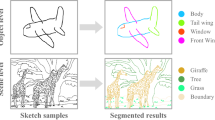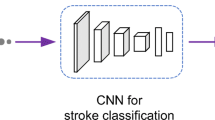Abstract
Sketch semantic segmentation presents great challenges, since sketches have simpler appearances and more levels of abstraction than natural images. To overcome these challenges, we propose a sketch semantic segmentation method. Concretely, we treat a sketch as a 2D point set and exploit the structures of strokes and the spatial position relationship among 2D points to develop a novel local feature aggregation module. The novel local feature aggregation module encodes informative local features, which are highly useful to analyze semantics. And we define “stroke distance” to balance the two-dimensional spatial distributions of sketches and the internal structures of strokes. Simultaneously, we design a segment-level self-attention module to establish and enhance the relationship between segments by encoding the contents and positions of segment features. Further, based on the above two modules, we construct a similar encoder–decoder structure with two sub-branches, which retains the features of the significant points and integrates the features of several intermediate stages by utilizing a global multi-scale mechanism. Finally, the two outputs of the two sub-branches are fused to obtain the final sketch semantic segmentation result. Extensive experiments on SPG and SketchSeg-150K show that our method achieves state-of-the-art results.











Similar content being viewed by others
Data availability
The data that support the findings of this study are available from the corresponding author upon reasonable request.
References
Li L, Zou CQ, Zheng YY et al (2021) Sketch-R2CNN: an RNN-rasterization-CNN architecture for vector sketch recognition. IEEE Trans Vis Comput Graph 27(9):3745–3754
Wan J, Zhang KH, Li HD et al (2021) Angular-driven feedback restoration networks for imperfect sketch recognition. IEEE Trans Image Process 30:5085–5095
Lin H, Fu Y, Jiang Y G et al (2020) Sketch-BERT: learning sketch bidirectional encoder representation from transformers by self-supervised learning of sketch gestalt. In: IEEE conference on computer vision and pattern recognition. IEEE Computer Society, pp 6757–6766
Zhang XL, Shen ML, Xue M et al (2022) A deformable CNN-based triplet model for fine-grained sketch-based image retrieval. Pattern Recognit 125:108508
Chen YD, Zhang ZL, Wang YF et al (2022) AE-Net: fine-grained sketch-based image retrieval via attention-enhanced network. Pattern Recognit 122:108291
Bhunia AK, Chowdhury PN, Sain A et al (2021) More photos are all you need: semi-supervised learning for fine-grained sketch based image retrieval. In: IEEE computer society conference on computer vision and pattern recognition. IEEE Computer Society, pp 4245–4254
Gryaditskaya YL, Song JF, Yang YX et al (2021) Toward fine-grained sketch-based 3d shape retrieval. IEEE Trans Image Process 30:8595–8606
He X, Zhou Y, Zhou Z et al (2018) Triplet-center loss for multi-view 3d object retrieval. In: IEEE conference on computer vision and pattern recognition. IEEE Computer Society, pp 1945–1954
Ge C, Sun HF, Song YZ et al (2022) Exploring local detail perception for scene sketch semantic segmentation. IEEE Trans Image Process 31:1447–1461
Yang LM, Zhuang JJ, Fu HB et al (2021) SketchGNN: semantic sketch segmentation with graph neural networks. ACM Trans Graph 40(3):1–13
Sarvadevabhatla RK, Dwivedi I, Biswas A et al (2017) Sketchparse: towards rich descriptions for poorly drawn sketches using multi-task hierarchical deep networks. In: ACM international conference on multimedia. Association for Computing Machinery, pp 10–18
Zhu MR, Li J, Wang NN et al (2021) Learning deep patch representation for probabilistic graphical model-based face sketch synthesis. Int J Comput Vision 129(6):1820–1836
Willis KD, Jayaraman PK, Lambourne JG et al (2021) Engineering sketch generation for computer-aided design. In: IEEE computer society conference on computer vision and pattern recognition workshops. IEEE Computer Society, pp 2105–2114
Xu BX, Chang W, Sheffer A et al (2014) True2Form: 3D curve networks from 2D sketches via selective regularization. ACM Trans Graph 33(4):1–13
Xu K, Chen K et al (2013) Sketch2scene: sketch-based co-retrieval and co-placement of 3d models. ACM Trans Graph 32(4):123:1-123:15
Pu JT, Gur D (2009) Automated freehand sketch segmentation using radial basis functions. CAD Comput Aided Des 41(12):857–864
Sun ZB, Wang CH, Zhang LQ et al (2012) Free hand-drawn sketch segmentation. European conference on computer vision. Springer, New York, pp 626–639
Schneider RG, Tuytelaars T (2016) Example-based sketch segmentation and labeling using CRFs. ACM Trans Graph 35(5):1–9
Wu XY, Qi YG, Liu J et al (2018) Sketchsegnet: aRNN model for labeling sketch strokes. In: IEEE international workshop on machine learning for signal processing. IEEE Computer Society, pp 1–6
Li K, Pang KY, Song YZ et al (2019) Towards deep universal sketch perceptual grouper. IEEE Trans Image Process 28(7):3219–3231
Qi YG, Tan ZH (2019) SketchSegNet+: an end-to-end learning of RNN for multi-class sketch semantic segmentation. IEEE Access 7:102717–102726
Li L, Fu HB, Tai CL (2019) Fast sketch segmentation and labeling with deep learning. IEEE Comput Graph Appl 39(2):38–51
Zhu XY, Xiao Y, Zheng Y (2020) 2D freehand sketch labeling using CNN and CRF. Multimed Tools Appl 79(3):1–18
Wang F, Lin SJ, Li HH et al (2020) Multi-column point-CNN for sketch segmentation. Neurocomputing 392:50–59
Wang F, Lin S, Wu H et al (2019) SPFusionNet: sketch segmentation using multi-modal data fusion. In: IEEE international conference on multimedia and expo. IEEE Computer Society, pp 1654–1659
Huang Z, Fu HB, Lau RWH et al (2014) Data-driven segmentation and labeling of freehand sketches. ACM Trans Graph 33(6):1–10
Long J, Shelhamer E, Darrell T (2015) Fully convolutional networks for semantic segmentation. IEEE Trans Pattern Anal Mach Intell 39(4):640–651
Badrinarayanan V, Kendall A, Cipolla R (2017) SegNet: a deep convolutional encoder–decoder architecture for image segmentation. IEEE Trans Pattern Anal Mach Intell 39(12):2481–2495
Chen LC, Papandreou G, Kokkinos I et al (2015) Semantic image segmentation with deep convolutional nets and fully connected CRFs. In: International conference on learning representations, ICLR
Chen LC, Papandreou G, Kokkinos I et al (2018) DeepLab: semantic image segmentation with deep convolutional nets, atrous convolution, and fully connected CRFs. IEEE Trans Pattern Anal Mach Intell 40(4):834–848
Chen LC, Papandreou G, Schroff F et al (2017) Rethinking atrous convolution for semantic image segmentation. arXiv preprint arXiv:1706.05587
Chen LC, Zhu Y, Papandreou G et al (2018) Encoder-decoder with atrous separable convolution for semantic image segmentation. European conference on computer vision. Springer, New York, pp 833–851
Ronneberger O, Fischer P, Brox T (2015) U-Net: convolutional networks for biomedical image segmentation. International conference on medical image computing and computer-assisted intervention. Springer Verlag, New York, pp 234–241
Oktay O, Schlemper J, Folgoc L L et al (2018) Attention U-Net: learning where to look for the pancreas. arXiv preprint arXiv:1804.03999
Zhou Z, Siddiquee M, Tajbakhsh N et al (2018) U-Net++: a nested U-Net architecture for medical image segmentation. Lect Notes Comput Sci 11045:3–11
Alom MZ, Hasan M, Yakopcic C et al (2018) Recurrent residual convolutional neural network based on U-Net (R2U-Net) for medical image segmentation. arXiv preprint arXiv:1802.06955
Zhang X, Xu HM, Mo H et al (2021) DCNAs: Densely connected neural architecture search for semantic image segmentation. In: IEEE conference on computer vision and pattern recognition. IEEE Computer Society, pp 13951–13962
Yu F, Koltun V (2016) Multi-scale context aggregation by dilated convolutions. In: International conference on learning representations, ICLR
Ma X, Qin C, You H X et al (2022) Rethinking network design and local geometry in point cloud: a simple residual MLP framework. arXiv preprint arXiv:2202.07123
Yu Q, Yang Y, Liu F et al (2017) Sketch-a-Net: a deep neural network that beats humans. Int J Comput Vision 122(3):411–425
Weinberger KQ, Saul LK (2009) Distance metric learning for large margin nearest neighbor classification. J Mach Learn Res 10:207–244
Stefano Z, Shabab B, Stefan H et al (2022) PolyWorld: polygonal building extraction with graph neural networks in satellite images. In: IEEE/CVF conference on computer vision and pattern recognition, IEEE
Odena A, Olah C, Shlens J (2017) Conditional image synthesis with auxiliary classifier gans. In: International conference on machine learning. IMLS, pp 4043–4055
Acknowledgements
We are very grateful to the editor and reviewers for their time and efforts while reviewing this manuscript. Besides, we also appreciate the support of the Central Government Guided Local Funds for Science and Technology Development (No. 216Z0301G), the National Natural Science Foundation of China (No. 61379065) and the Natural Science Foundation of Hebei Province in China (No. F2019203285).
Author information
Authors and Affiliations
Corresponding author
Ethics declarations
Conflict of interest
No potential conflict of interest was reported by the authors.
Additional information
Publisher's Note
Springer Nature remains neutral with regard to jurisdictional claims in published maps and institutional affiliations.
Rights and permissions
Springer Nature or its licensor (e.g. a society or other partner) holds exclusive rights to this article under a publishing agreement with the author(s) or other rightsholder(s); author self-archiving of the accepted manuscript version of this article is solely governed by the terms of such publishing agreement and applicable law.
About this article
Cite this article
Wang, L., Zhang, S., Wang, W. et al. A sketch semantic segmentation method using novel local feature aggregation and segment-level self-attention. Neural Comput & Applic 35, 15295–15313 (2023). https://doi.org/10.1007/s00521-023-08504-1
Received:
Accepted:
Published:
Issue Date:
DOI: https://doi.org/10.1007/s00521-023-08504-1




